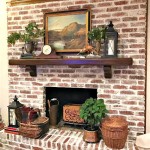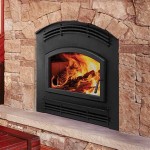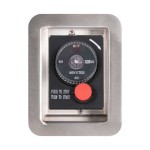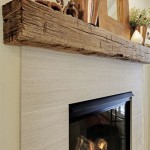How To Decorate a Living Room With a Fireplace
The fireplace often serves as the focal point in a living room, drawing the eye and providing a natural gathering place. Decorating around a fireplace requires careful consideration of its architectural style, the room's overall aesthetic, and the practical needs of the inhabitants. A well-decorated fireplace area can enhance the ambiance of the living room, creating a warm, inviting, and stylish space.
There are various factors that influence a design scheme. The existing architecture, the availability of natural light, and the intended use of the room must all considered. Furthermore, the fireplace itself may dictate certain design decisions. A modern, minimalist fireplace will require a different approach than a traditional, ornate one.
Effectively decorating a living room with a fireplace involves several key aspects, including choosing the right mantel decor, arranging furniture to maximize the fireplace's impact, and incorporating complementary accessories to create a cohesive design.
Choosing the Right Mantel Decor
The mantel is a prime opportunity to showcase personal style and create a visually appealing display. Several approaches exist for decorating a mantel, each offering a distinct aesthetic. The selection should complement the existing architectural style of the fireplace and the overall design theme of the living room.
A balanced mantel display is crucial for visual harmony. Symmetry is a common approach, involving identical items placed on either side of a central focal point, such as a mirror or artwork. Alternatively, asymmetry creates a more relaxed and contemporary feel. This approach involves arranging objects of varying heights and textures, ensuring a visual balance without exact replication.
Artwork is a popular choice for mantel decor. A large canvas or framed print can serve as a striking focal point. The artwork's style and color palette should complement the room's design. Consider the scale of the artwork relative to the fireplace and the surrounding wall space. The artwork should not overwhelm the fireplace but rather enhance its presence.
Mirrors are another excellent option for complementing the fireplace. Mirrors reflect light, making a room feel larger and brighter. A decorative mirror placed above the fireplace can add a touch of elegance and sophistication. The frame of the mirror should complement the fireplace's architectural style. A simple, minimalist frame works well with a modern fireplace, while an ornate, decorative frame may be appropriate for a traditional fireplace.
Candles and candle holders can create a warm and inviting atmosphere. Varying the heights of the candles adds visual interest. Consider using scented candles to enhance the ambiance of the room. Candle holders should complement the fireplace's style. Metal or glass candle holders work well with modern fireplaces, while antique or rustic candle holders may be appropriate for a traditional fireplace.
Greenery, such as plants or flowers, can bring life and freshness to the mantel. Potted plants, vases of flowers, or trailing vines can add a touch of nature to the room. Choose plants that thrive in the lighting conditions of the living room. Consider the color and texture of the greenery to complement the room's design. Seasonal greenery, such as pine branches in winter or vibrant flowers in spring, can add a festive touch.
Personal collections, such as books, sculptures, or decorative objects, can add personality and character to the mantel. Arrange the objects in a visually appealing way, considering their size, shape, and color. Avoid cluttering the mantel with too many items. A curated collection of a few well-chosen objects can be more impactful than a cluttered display.
Consider the seasonal changes. A fireplace mantel can be easily adapted to reflect the changing seasons. In the fall, consider displaying pumpkins, gourds, and fall foliage. In the winter, consider displaying pine branches, ornaments, and candles. In the spring, consider displaying flowers, plants, and pastel-colored accessories. In the summer, consider displaying seashells, starfish, and other beach-themed items.
Arranging Furniture To Maximize the Fireplace's Impact
The arrangement of furniture is crucial for creating a functional and aesthetically pleasing living room design. A fireplace, as a natural focal point, influences the furniture layout significantly. Thoughtful furniture placement can enhance the fireplace's impact and create a comfortable and inviting space for relaxation and socializing.
Creating a focal point around the fireplace is essential. The main seating area should be oriented towards the fireplace, allowing people to easily enjoy its warmth and visual appeal. Position sofas and chairs to encourage conversation and create a sense of intimacy. Avoid placing furniture in a way that blocks the view of the fireplace.
A symmetrical furniture arrangement can create a sense of balance and formality. In this approach, identical sofas or chairs are placed on either side of the fireplace, creating a mirror image. A coffee table is typically placed in the center of the seating area, providing a convenient surface for drinks and snacks. This arrangement works well in traditional living rooms.
An asymmetrical furniture arrangement can create a more relaxed and contemporary feel. This approach involves arranging furniture in a way that is not perfectly symmetrical. For example, a sofa could be placed on one side of the fireplace, with two chairs placed on the other side. The key is to achieve a visual balance without exact replication. This arrangement works well in modern living rooms.
Consider the traffic flow in the living room when arranging furniture. Ensure that there is enough space to move around comfortably. Avoid placing furniture in a way that blocks doorways or creates obstacles. Create clear pathways between different areas of the room. This is especially important in larger living rooms.
The size and scale of the furniture should be appropriate for the size of the living room. Avoid using oversized furniture in a small living room, as this can make the room feel cramped and claustrophobic. Conversely, avoid using undersized furniture in a large living room, as this can make the room feel empty and impersonal. Choose furniture that is proportional to the size of the room and the fireplace.
Rugs can help to define the seating area and anchor the furniture. Choose a rug that is large enough to accommodate all of the furniture in the seating area. The rug's color and pattern should complement the room's design. A rug can also add warmth and texture to the room.
Lighting plays a crucial role in setting the mood in a living room. Incorporate a variety of lighting sources, including ambient lighting, task lighting, and accent lighting. Ambient lighting provides overall illumination for the room. Task lighting provides focused lighting for reading or other activities. Accent lighting highlights specific features, such as the fireplace or artwork. Table lamps, floor lamps, and sconces can all be used to create a layered lighting scheme.
Incorporating Complementary Accessories
Accessories are the finishing touches that add personality and character to a living room, complementing the fireplace and enhancing the overall design. Carefully chosen accessories can tie the room together, creating a cohesive and stylish space. The selection and placement of accessories require attention to detail and an understanding of design principles.
Throw pillows and blankets can add comfort and style to the seating area. Choose pillows and blankets in a variety of colors, patterns, and textures. Consider the seasonal changes when selecting pillows and blankets. Lighter fabrics and brighter colors are appropriate for spring and summer, while heavier fabrics and warmer colors are appropriate for fall and winter. Arrange the pillows and blankets in a visually appealing way, adding depth and dimension to the seating area.
Wall decor can add visual interest and personality to the living room. Artwork, mirrors, and decorative objects can all be used to enhance the walls. Consider the scale of the wall decor relative to the size of the wall. Avoid overcrowding the walls with too many items. A few well-chosen pieces can be more impactful than a cluttered display. The style and color of the wall decor should complement the room's design.
Coffee table decor can add a touch of elegance and sophistication to the living room. A coffee table book, a decorative tray, or a vase of flowers can all be used to enhance the coffee table. Arrange the objects in a visually appealing way, considering their size, shape, and color. Avoid cluttering the coffee table with too many items. A few well-chosen objects can be more impactful than a cluttered display.
Bookshelves can provide storage and display space in the living room. Arrange the books in a visually appealing way, considering their size, shape, and color. Interspersed decorative objects, such as picture frames, plants, and sculptures, to add visual interest. Consider the style of the bookshelves to complement the room's design.
Rugs can help to define the different areas of the living room. Choose rugs in a variety of colors, patterns, and textures. Consider the size and shape of the rug relative to the size of the area. A rug can also add warmth and comfort to the room.
Curtains or blinds can add privacy and control the amount of light entering the living room. Choose curtains or blinds in a variety of colors, patterns, and fabrics. Consider the style of the curtains or blinds to complement the room's design. Curtains can add softness and elegance to the room, while blinds can provide a more modern and minimalist look.
Lighting fixtures can add both functionality and style to the living room. Table lamps, floor lamps, and ceiling fixtures can all be used to create a layered lighting scheme. Consider the style of the lighting fixtures to complement the room's design. A well-lit living room is both inviting and functional.
Remember that carefully selected accessories reinforce the design, while poorly chosen accessories detract from the overall aesthetic. Regularly re-evaluate the accessories to ensure they complement the fireplace and the living room design.

Sprucing Up Your Home S Living Room With Fireplace By Expert

11 Appealing Living Room Designs With A Fireplace

40 Best Fireplace Décor Ideas Mantel
Interior Designers Reveal The Mistakes You Re Making In A Living Room

7 Inspirational Living Room Layout Ideas

12 Gorgeous Home Decor Ideas For Styling An Empty Living Room Fireplace

Fireplace Design Ideas For Your Home Designcafe
Why A Focal Point Doesn T Always Need To Be Fireplace The Living House

Custom Built Fireplace Ideas For A Living Room

19 Stunning Rustic Living Rooms With Charming Stone Fireplace Room Design Family Farm House








